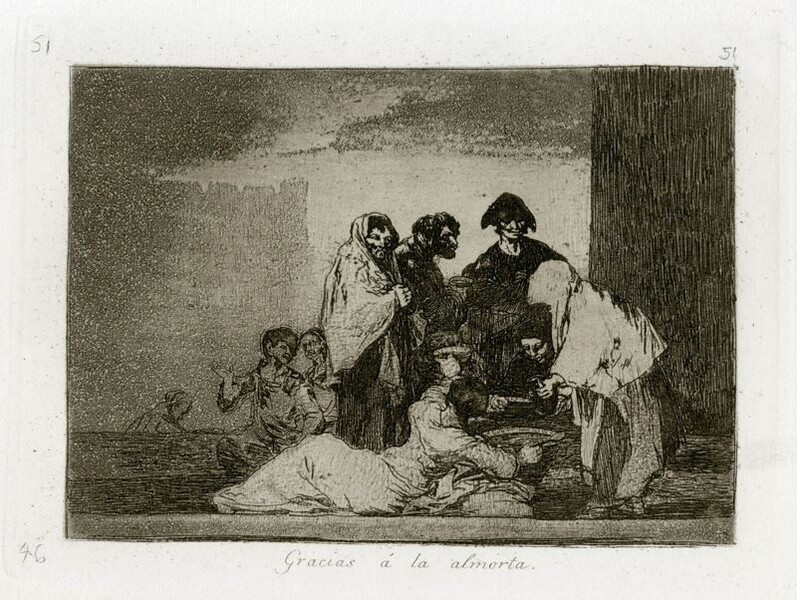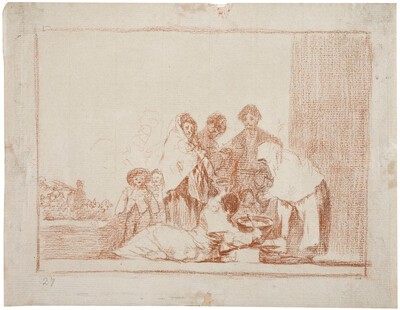- Cronología
- Ca. 1812 - 1815
- Dimensiones
- 156 x 205 mm
- Técnica y soporte
- Etching and burnished aquatint
- Reconocimiento de la autoría de Goya
- Undisputed work
- Ficha: realización/revisión
- 15 Dec 2010 / 11 Jan 2024
- Inventario
- 225
46 (on the lower left-hand corner).
See Sad presentiments of what must come to pass.
The title was handwritten on the print by Goya in the first and only series that is known to have been printed at the time the works were created, which the artist gave to his friend Agustín Ceán Bermúdez. Therefore, the title was etched into the plate at a later date and left unchanged as of the first edition of the Disasters of War printed by the San Fernando Royal Academy of Fine Arts in Madrid in 1863, after the printing of the series in the possession of Ceán Bermúdez.
There is a surviving preparatory drawing for this print which is housed in the Prado Museum in Madrid.
A woman whose face is invisible to the viewer and who is completely covered from head to foot is giving out food to a group of starving people. The food seems to be soup, most probably made with grass pea flour, as indicated by the print title. In the foreground is a woman lying on the ground dressed in white and clutching a spoon in her hand who holds out her plate with her outstretched arm. Behind her are three standing figures whose faces are caricatures: their pronounced jaws and cheekbones, sharp noses and sunken eyes denote that they have been suffered greatly during the famine that devastated Spain at the time of the Spanish War of Independence. The figures' clothing is eccentric and ragged garments obtained by any means possible during the war, some of which doubtless originally belonged to others. In the middle ground Goya has placed two women with spectral faces who have perhaps already consumed their ration of soup. They are clearly reminiscent of the figures depicted in another work by the artist, Old Women (Las viejas).
The grass pea was used as a substitute for other cereals during the war, since it would grow in extremely harsh conditions even if it was not well tended. Prolonged consumption of large quantities of this legume could lead to serious illnesses such as lathyrism, which causes spasmodic paraplegia and can cause serious growth problems in children. With the title of this work, Thanks to the grass pea, Goya makes reference to all the issues associated with this product. On the one hand, it served to alleviate hunger, but on the other hand it also caused diseases and even death. Perhaps this is the key to interpreting the sinister cloaked figure who gives out food to the needy, simultaneously contributing to the poisoning of all those who ate it.
The plate is stored in the National Chalcography (cat. 302).
-
Goya and his timesThe Royal Academy of ArtsLondon1963cat. 66cat. 247
-
Francisco Goya. Sein leben im spiegel der graphik. Fuendetodos 1746-1828 Bordeaux. 1746-1996Galerie KornfeldBern1996from November 21st 1996 to January 1997cat. 135
-
Francisco de GoyaMuseo d'Arte ModernaLugano1996exhibition celebrated from September 22nd to November 17th.cat. 51
-
Francisco de Goya: Maleri, Tegning, GrafikkNasjonalgallerietOslo1996from 10th to April 14th 1996cat. 144
-
Francisco Goya. Capricci, follie e disastri della guerraSan Donato Milanese2000Opere grafiche della Fondazione Antonio Mazzottacat. 131
-
Goya. Opera graficaPinacoteca del Castello di San GiorgioLegnano2006exhibition celebrated from December 16th 2006 to April 1st 2007p. 76
-
Goya et la modernitéPinacothèque de ParisParís2013from October 11st 2013 to March 16th 2014cat. 90
-
2022
-
Goya, grabadorMadridBlass S.A.1918cat. 153
-
Goya engravings and lithographs, vol. I y II.OxfordBruno Cassirer1964cat. 171
-
Vie et ouvre de Francisco de GoyaParísOffice du livre1970cat. 1076
-
Catálogo de las estampas de Goya en la Biblioteca NacionalMadridMinisterio de Educación y Cultura, Biblioteca Nacional1996cat. 260
-
Francisco de Goya. Los Desastres de la guerraBarcelonaLa Central2011p. 21
-
ParísPinacoteca de París2013p. 145
-
Goya. In the Norton Simon MuseumPasadenaNorton Simon Museum2016pp. 114-151
-
Museo de Bellas Artes de Badajoz y Diputación de Badajoz2022p. 72

